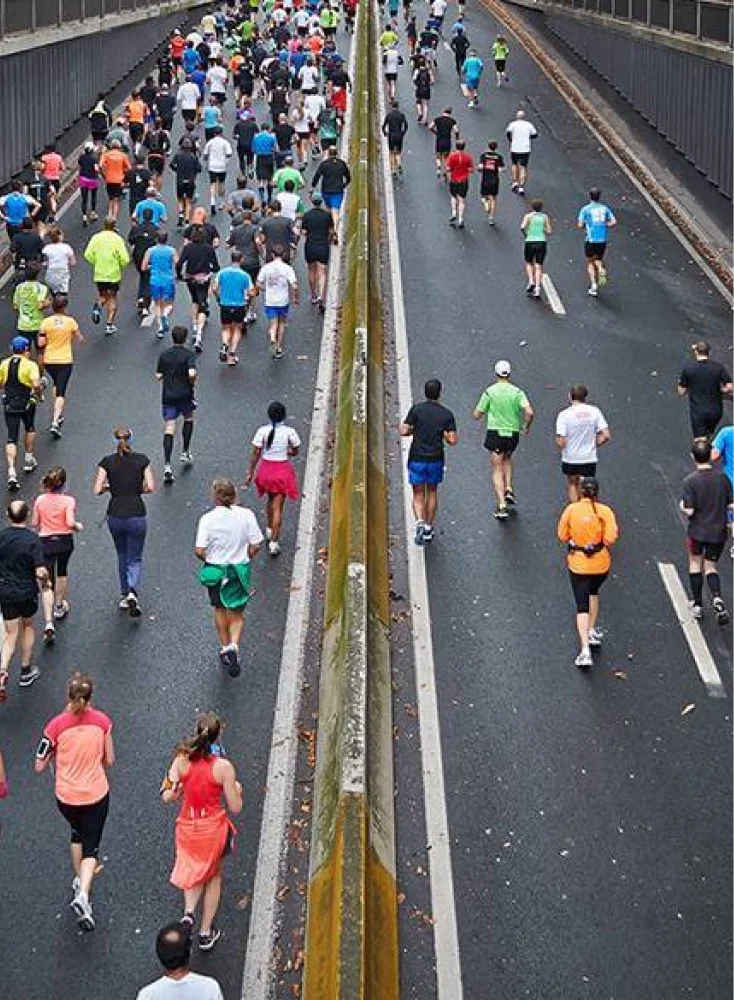
Running
How to Run a Faster Marathon
For many, their first marathon is about getting to know the distance and realising they can achieve 26.2 miles. Once you have run your first marathon and your body has had time to recover, you may want to improve the time you set down.
1 min read
Published on
May 31, 2019
Written by
EDGE
Share this article
We spoke to Matt Sharp, former World Under-23 champion at triathlon and 2hr 16min marathon runner, to get his tips on how you can run a faster marathon.
A STRONG MINDSET
“In moving from triathlon to marathon, I’ve realised there are a lot of physical and mental attributes that benefit both events,” says Matt. “Obviously, the endurance side of marathon training is vital, but the mental side is often overlooked my many. When you run your first marathon the distance can be very daunting, and a real unknown if you haven’t prepared as well as you could have. Personally, I found the second marathon slightly easier mentally, as I knew I would actually complete the distance.”
TOP UP TRAINING WITH A HALF MARATHON
Many top marathoners will compete in a half marathon race approximately five to eight weeks out from their big race. “The idea is to validate the training you have already done,” says Matt, “and to allow the body to fully recover and get in some specific training before the main race.”
Getting in a race of at least 10 miles will also allow you to practise your nutrition strategy and pacing in a race scenario, with all the distractions that go along with a competition. “Use this warm-up race as an opportunity to get your fueling right,” says Matt. “This won’t make you run faster at the start of the race, but it will make a huge difference in the later parts. From personal experience, I can confirm that under fueling early on will result in a slow and painful last few miles!”
If it’s a hot or humid day it’s a good idea to slightly increase the amount of fluid you consume at each drinks station. “Having a drink which includes both sugars and electrolytes is a good idea for people who suffer from cramps or are overly salty sweaters,” he adds. “The added electrolytes will help reduce the negative symptoms associated with dehydration.”
TRAINING AT MARATHON PACE
However, do the right training and you will feel confident to run your next marathon faster. The long run will prepare you for race day. “I would say incorporating a long run into your training is key, with the aim of running at least three or four 20-mile runs before the competition to build your endurance and give yourself confidence for the full distance,” suggests Matt.
However, you don’t want every mile of your long run to be at marathon target pace. It’s a good idea to do the first third slow, the middle third at marathon pace, then the last third slow. Alternatively, run the second half of your long run faster than the first, and aim to do the last four or five miles at target pace. By this stage your legs will be fatigued. Being able to run at target pace at the end of your long run will be a good indicator of a realistic goal time.
RESPECT YOUR REST DAYS
Your rest days are critical, to allow your body and muscles to adapt to the training load you put them under. Rest will also help reduce injury; make sure you have at least one day off running every week, and try to follow a hard day/hard session with an easy/recovery run. Rest days allow you to hit your tough sessions at the right level. “While it is important to complete a number of long runs in your preparation, consistency is king when it comes to the marathon,” says Matt. “Respect your body and incorporate rest and recovery days into every training week. I also find having regular massage helps the muscles and joints recover after hard training, and is a great way to keep on top of any tight areas that may negatively affect your training later on.”
PRACTISE YOUR NUTRITION
No one wants to spend time in the porta-loos along a marathon course unless they have to. Saving precious time by practicing your nutrition before the event is crucial.
“If you plan on using gels or have a favourite race drink, it’s a good idea to use them as much as possible during your training in the weeks leading up to your race,” advises Matt. “By using the same nutrition plan in training as you plan to use when competing you can train your gut to absorb the calories and hopefully avoid any stomach issues on race day.”
Don’t drink so much during the race that you have to constantly stop, either. Make sure you are fully hydrated before the race; your pee should be straw coloured. You can work out how much fluid you need to take on by finding out how much weight you lose when you run. Just weigh yourself before and after a race. One pound of weight loss should equal approximately one pint of fluid intake.
THE RIGHT KIT
One final point on distance running is the important of the shoes on your feet. “Having a shoe that you are comfortable in and fits well will make a huge difference to your training,” believes Matt. Make sure you get fitted for the right shoes for your gait. “It’s also worth checking the condition of your shoes regularly if you are racking up the miles, as worn out shoes can lead to easily avoidable injuries,” he says.
Blood test for
Runners
Male & Female Tests
sports doctor review
Results in 2 working days
Flexible subscription
Get 10% off your first order
Want regular tips on how to make the most of your results? Join our newsletter and we'll give you 10% off your order!
